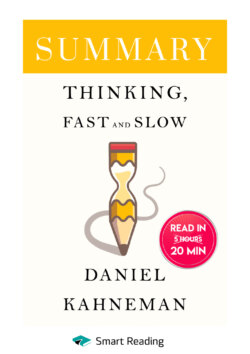Summary: Thinking, Fast and Slow. Daniel Kahneman

Реклама. ООО «ЛитРес», ИНН: 7719571260.
Оглавление
Smart Reading. Summary: Thinking, Fast and Slow. Daniel Kahneman
Two Systems of Thinking
Conflict of Two Systems of Thinking and Self-control
Associative Machine
Illusion of Truth
Machine for Jumping to Conclusions
Answering an Easier Question
Anchoring Effect
Availability
Dealing with Intuitive Predictions
Hindsight and Recipes for Success
Engine of Capitalism
Re-evaluation of Rare Events
Отрывок из книги
We can usually tell what we're thinking. The process of thinking seems clear: one conscious thought naturally causes the next one. But basically, the mind works differently. Most of our thoughts arise in unknown ways, and the mental work that leads to impressions, hunches, and decisions usually goes unnoticed.
There are two modes of thinking. To define the first mode – intuitive, spontaneous – the term "fast thinking" is used, and the second one – conscious, reasonable – is called "slow thinking".
.....
Fast thinking includes expert knowledge and unconscious attitude, as well as all those absolutely automatic actions of the brain in the field of perception and memory that help us remember exactly the capital of England or recognize that there is a lamp on the table. But from time to time a reasonable answer doesn't come to mind, and in such cases we switch to a deeper form of thinking that requires more effort. This is slow thinking. With the help of slow thinking, you can prepare for the start signal in the race, hear the voice of the right person in a crowded noisy room, remember a sound that startled you by rummaging through your memory banks, intentionally speed up your pace, dictate your phone number to the person you are speaking to, etc. In all these situations, you need to be attentive, and if you are not ready or distracted, you will fare even worse, if not manage at all. One of the main functions of slow thinking is to monitor and control the thoughts and actions prompted by fast thinking.
Slow and fast thinking can interact. Fast thinking works automatically, while slow thinking works in a comfortable mode of minimal effort. Fast thinking constantly generates offers for slow thinking: impressions, premonitions, intentions and feelings. If slow thinking approves of them, then impressions and premonitions turn into convictions, and impulses into intentional actions. When everything goes smoothly – and it almost always does – the slow thinking accepts the offer of the fast thinking with little or no change. As a rule, you believe your impressions and act according to your desires, which is quite acceptable.
.....